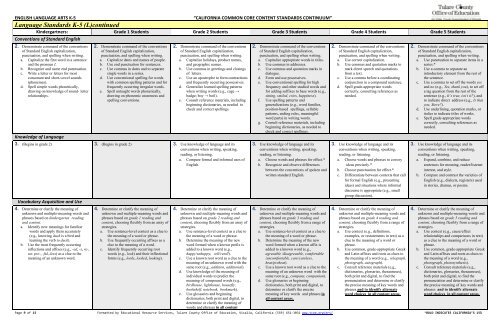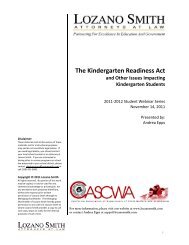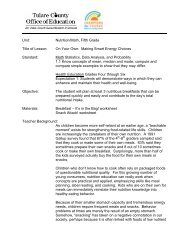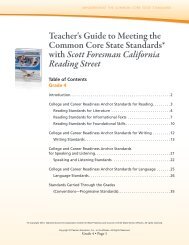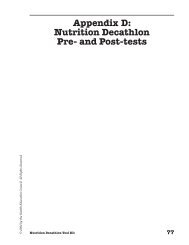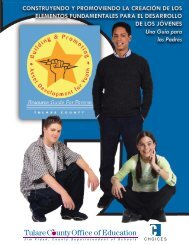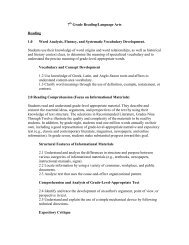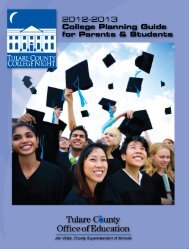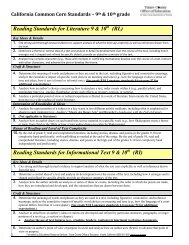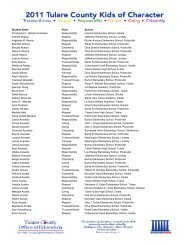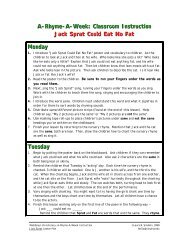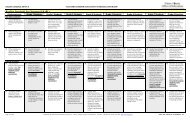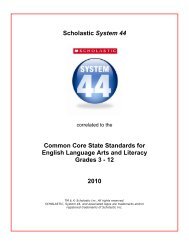CCCS K-5 ELA Continuum - Tulare County Office of Education
CCCS K-5 ELA Continuum - Tulare County Office of Education
CCCS K-5 ELA Continuum - Tulare County Office of Education
- No tags were found...
You also want an ePaper? Increase the reach of your titles
YUMPU automatically turns print PDFs into web optimized ePapers that Google loves.
ENGLISH LANGUAGE ARTS K‐5 “CALIFORNIA COMMON CORE CONTENT STANDARDS CONTINUUM”Language Standards K-5 (L)continuedKindergartners: Grade 1 Students Grade 2 Students Grade 3 Students Grade 4 Students Grade 5 StudentsConventions <strong>of</strong> Standard English2. Demonstrate command <strong>of</strong> the conventions<strong>of</strong> Standard English capitalization,punctuation, and spelling when writing.a. Capitalize the first word in a sentenceand the pronoun I.b. Recognize and name end punctuation.c. Write a letter or letters for mostconsonant and short-vowel sounds(phonemes).d. Spell simple words phonetically,drawing on knowledge <strong>of</strong> sound- letterrelationships.2. Demonstrate command <strong>of</strong> the conventions<strong>of</strong> Standard English capitalization,punctuation, and spelling when writing.a. Capitalize dates and names <strong>of</strong> people.b. Use end punctuation for sentences.c. Use commas in dates and to separatesingle words in a series.d. Use conventional spelling for wordswith common spelling patterns and forfrequently occurring irregular words.e. Spell untaught words phonetically,drawing on phonemic awareness andspelling conventions.2. Demonstrate command <strong>of</strong> the conventions<strong>of</strong> Standard English capitalization,punctuation, and spelling when writing.a. Capitalize holidays, product names,and geographic names.b. Use commas in greetings and closings<strong>of</strong> letters.c. Use an apostrophe to form contractionsand frequently occurring possessives.d. Generalize learned spelling patternswhen writing words (e.g., cage →badge; boy → boil).e. Consult reference materials, includingbeginning dictionaries, as needed tocheck and correct spellings.Knowledge <strong>of</strong> Language3. (Begins in grade 2) 3. (Begins in grade 2) 3. Use knowledge <strong>of</strong> language and itsconventions when writing, speaking,reading, or listening.a. Compare formal and informal uses <strong>of</strong>English.Vocabulary Acquisition and Use4. Determine or clarify the meaning <strong>of</strong>unknown and multiple-meaning words andphrases based on kindergarten readingand content.a. Identify new meanings for familiarwords and apply them accurately(e.g., knowing duck is a bird andlearning the verb to duck).b. Use the most frequently occurringinflections and affixes (e.g., -ed, -s, re-,un- pre-, -ful,-less) as a clue to themeaning <strong>of</strong> an unknown word.4. Determine or clarify the meaning <strong>of</strong>unknown and multiple-meaning words andphrases based on grade 1 reading andcontent, choosing flexibly from an array <strong>of</strong>strategies.a. Use sentence-level context as a clue tothe meaning <strong>of</strong> a word or phrase.b. Use frequently occurring affixes as aclue to the meaning <strong>of</strong> a word.c. Identify frequently occurring rootwords (e.g., look) and their inflectionalforms (e.g., looks, looked, looking).4. Determine or clarify the meaning <strong>of</strong>unknown and multiple-meaning words andphrases based on grade 2 reading andcontent, choosing flexibly from an array <strong>of</strong>strategies.a. Use sentence-level context as a clue tothe meaning <strong>of</strong> a word or phrase.b. Determine the meaning <strong>of</strong> the newword formed when a known prefix isadded to a known word (e.g.,happy/unhappy, tell/retell).c. Use a known root word as a clue to themeaning <strong>of</strong> an unknown word with thesame root (e.g., addition, additional).d. Use knowledge <strong>of</strong> the meaning <strong>of</strong>individual words to predict themeaning <strong>of</strong> compound words (e.g.,birdhouse, lighthouse, housefly;bookshelf, notebook, bookmark).e. Use glossaries and beginningdictionaries, both print and digital, todetermine or clarify the meaning <strong>of</strong>words and phrases in all content2. Demonstrate command <strong>of</strong> the conventions<strong>of</strong> Standard English capitalization,punctuation, and spelling when writing.a. Capitalize appropriate words in titles.b. Use commas in addresses.c. Use commas and quotation marks indialogue.d. Form and use possessives.e. Use conventional spelling for highfrequency and other studied words andfor adding suffixes to base words (e.g.,sitting, smiled, cries, happiness).f. Use spelling patterns andgeneralizations (e.g., word families,position-based spellings, syllablepatterns, ending rules, meaningfulword parts) in writing words.g. Consult reference materials, includingbeginning dictionaries, as needed tocheck and correct spellings.3. Use knowledge <strong>of</strong> language and itsconventions when writing, speaking,reading, or listening.a. Choose words and phrases for effect.*b. Recognize and observe differencesbetween the conventions <strong>of</strong> spoken andwritten standard English.4. Determine or clarify the meaning <strong>of</strong>unknown and multiple-meaning words andphrases based on grade 3 reading andcontent, choosing flexibly from a range <strong>of</strong>strategies.a. Use sentence-level context as a clue tothe meaning <strong>of</strong> a word or phrase.b. Determine the meaning <strong>of</strong> the newword formed when a known affix isadded to a known word (e.g.,agreeable /disagreeable, comfortable/uncomfortable, care/careless,heat/preheat).c. Use a known root word as a clue to themeaning <strong>of</strong> an unknown word with thesame root (e.g., company, companion).d. Use glossaries or beginningdictionaries, both print and digital, todetermine or clarify the precisemeaning <strong>of</strong> key words and phrases inall content areas.2. Demonstrate command <strong>of</strong> the conventions<strong>of</strong> Standard English capitalization,punctuation, and spelling when writing.a. Use correct capitalization.b. Use commas and quotation marks tomark direct speech and quotationsfrom a text.c. Use a comma before a coordinatingconjunction in a compound sentence.d. Spell grade-appropriate wordscorrectly, consulting references asneeded.3. Use knowledge <strong>of</strong> language and itsconventions when writing, speaking,reading, or listening.a. Choose words and phrases to conveyideas precisely.*b. Choose punctuation for effect.*c. Differentiate between contexts that callfor formal English (e.g., presentingideas) and situations where informaldiscourse is appropriate (e.g., smallgroup discussion).4. Determine or clarify the meaning <strong>of</strong>unknown and multiple-meaning words andphrases based on grade 4 reading andcontent, choosing flexibly from a range <strong>of</strong>strategies.a. Use context (e.g., definitions,examples, or restatements in text) as aclue to the meaning <strong>of</strong> a word orphrase.b. Use common, grade-appropriate Greekand Latin affixes and roots as clues tothe meaning <strong>of</strong> a word (e.g., telegraph,photograph, autograph).c. Consult reference materials (e.g.,dictionaries, glossaries, thesauruses),both print and digital, to find thepronunciation and determine or clarifythe precise meaning <strong>of</strong> key words andphrases and to identify alternateword choices in all content areas.2. Demonstrate command <strong>of</strong> the conventions<strong>of</strong> Standard English capitalization,punctuation, and spelling when writing.a. Use punctuation to separate items in aseries.*b. Use a comma to separate anintroductory element from the rest <strong>of</strong>the sentence.c. Use a comma to set <strong>of</strong>f the words yesand no (e.g., Yes, thank you), to set <strong>of</strong>fa tag question from the rest <strong>of</strong> thesentence (e.g., It’s true, isn’t it?), andto indicate direct address (e.g., Is thatyou, Steve?).d. Use underlining, quotation marks, oritalics to indicate titles <strong>of</strong> works.e. Spell grade-appropriate wordscorrectly, consulting references asneeded.3. Use knowledge <strong>of</strong> language and itsconventions when writing, speaking,reading, or listening.a. Expand, combine, and reducesentences for meaning, reader/listenerinterest, and style.b. Compare and contrast the varieties <strong>of</strong>English (e.g., dialects, registers) usedin stories, dramas, or poems.4. Determine or clarify the meaning <strong>of</strong>unknown and multiple-meaning words andphrases based on grade 5 reading andcontent, choosing flexibly from a range <strong>of</strong>strategies.a. Use context (e.g., cause/effectrelationships and comparisons in text)as a clue to the meaning <strong>of</strong> a word orphrase.b. Use common, grade-appropriate Greekand Latin affixes and roots as clues tothe meaning <strong>of</strong> a word (e.g.,photograph, photosynthesis).c. Consult reference materials (e.g.,dictionaries, glossaries, thesauruses),both print and digital, to find thepronunciation and determine or clarifythe precise meaning <strong>of</strong> key words andphrases and to identify alternateword choices in all content areas.Page 9 <strong>of</strong> 15 Formatted by <strong>Education</strong>al Resource Services, <strong>Tulare</strong> <strong>County</strong> <strong>Office</strong> <strong>of</strong> <strong>Education</strong>, Visalia, California (559) 651‐3031 www.tcoe.org/ers/ *BOLD INDICATES CALIFORNIA’S 15%


